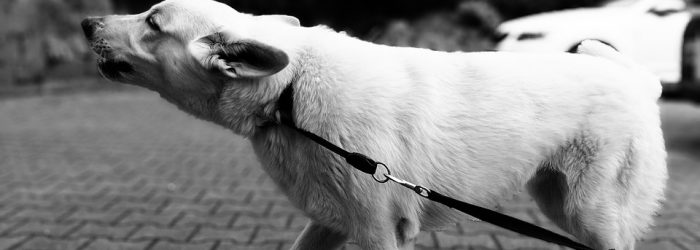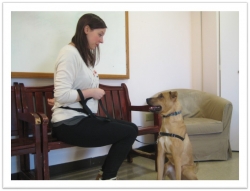
A little over a year ago, I adopted a 6 year old 70 lb. mixed breed dog named Lola, with a lifelong history of barking, growling and lunging at strangers. To her, any unfamiliar human was assumed to be an existential threat to her life. She had good reason for this belief, but her reasons are ultimately unimportant. What mattered was that she had 6 years of experience behind her that told her strangers were something to fear AND she could make the scary people go away by being scary herself.
When I first adopted her, she would make strangers go away by lunging violently at the end of her leash toward the strangers. Her hackles would be up (the hair along the back of her neck and ridge of her back would be standing on end). She’d be barking and snarling and growling, while straining at the end of her leash and sometimes jumping in the air or spinning round violently to try different angles to break free of her restraint so she could charge the stranger. She would throw her full weight behind it, and at 70 lbs of muscle, that was a lot to hold onto. She reminded me of the Tasmanian devil from the cartoons. She would do this no matter how far away the human was. If there was a stranger anywhere in her line of sight, she was going to put on this display to make the bad person go away. The one exception was if the stranger surprised her by suddenly appearing within about 10-15 feet, then she would tuck tail and run in the opposite direction as fast as she could.
Of course, adopting a dog like this is not a decision that should be taken lightly. In my case, I had already worked with Lola for about a year before I decided to adopt her. While there were many behaviors I simply couldn’t address in the shelter setting, I had been able to teach her to walk through a busy lobby without her even stiffening up when she saw the strangers. It was a very specific situation and I had to be very proactive every single time, but it proved she could be taught an alternative to snarling and lunging. It proved she wasn’t a lost cause and I knew, if I could get her into a different situation, I’d be able to, at the very least, make significant improvements with her. In that year, I also got to know her sweet, affection side, and I felt she deserved the chance to become the happy, content dog I saw in those private moments. I knew it would be hard and time consuming, but I believed she could learn to live without that constant, crippling panic.
There have been times, along her road to recovery, where I have doubted that belief. I have questioned from time to time whether I would, in the end, really be able to help her live a fulfilled, fear-free life. Even as I had helped many others find ways to help their own dogs, I occasionally questioned whether I could do it for Lola. Early on in our journey together, I found it difficult to cope with her frequent reactive moments. I felt each of her reactions personally. I would physically tense up when she’d lunge or bark. My adrenaline would start pumping and I was feeling stressed out all the time. I also blamed myself for each incident, feeling like I personally had failed her.
It was quite a different experience for me than working with my clients or working with rescue dogs. With them, I was always able to maintain my professional perspective. I’m the kind of trainer who, when my clients chastise themselves for small errors, I will remind them that mistakes happen and it’s not a big deal. I encourage my clients to give themselves room to make mistakes. Mistakes are an opportunity to learn to do things better in the future. Moreover, some things are just out of our control. However, in the first four months or so after I adopted Lola, I struggled to maintain that frame of mind for myself.
Early in the process, I thrilled at every minute improvement I saw in Lola. On the flip side, I felt despair each time we had a setback, no matter how minor. I was, fortunately, able to maintain my faith in my methods through all this emotional turmoil. I knew I needed to stick with my treatment plan and give it time to work, and thank goodness I did. Somewhere around 4-5 months into our treatment plan, I had finally gotten to a point where Lola could stay mostly chill and focused on me so long as the strangers in the area were at least 50 feet away and not shouting or running. If they were completely stationary, then we could get even closer without her tensing up. It may not sound all that great but it was night and day compared to where we started. It was around this time that I realized I needed to work on my own mindset.
Sure, Lola had improved a lot and it felt like we’d reached a major milestone in her training, but I was still struggling with my own feelings on our walks. For the first time, I’d been able to walk Lola down one side of the street while someone passed us on the opposite sidewalk. They were probably only 40 feet away and we were both moving. It was amazing. Then a few days later I was walking Lola and she totally lost her head, and turned into a whirling dervish of teeth and hair when she saw someone at least 150 feet away. I was initially crestfallen. Then I reminded myself of something that I always tell my clients. Setbacks happen. As long as the general trend is positive, you shouldn’t worry about setbacks. Ride it out, be cautious for a little while, and keep moving forward. It occurred to me as I was repeating this familiar sentiment to myself, that it wasn’t enough to know it intellectually. It occurred to me that I needed to really feel it. I needed to embrace the ups and downs. I needed to surrender to the current, rather than fight it. In the following days and weeks as I attempted to find a new level of emotional acceptance, I found I was starting to feel a lot more relaxed about our walks together. If Lola had a reaction, it didn’t upset me the way it used to. I felt almost at peace with her outbursts, because I knew we were still working on it and we would get there eventually. I found a new level of compassion for both myself and my dog once I’d learned to lean into the uncertainty. Instead of tensing up when my dog had a freak out, I found myself calmly offering comfort. I’d say things like “I know. Scary human, but you’re alright.” Lola seemed to find this approach soothing, and our training became even more effective.
Now, look, I’m still human. I still get frustrated sometimes. I still get annoyed when things don’t go my way. But the key difference is that I don’t get down on myself or my dog when things go badly. This change in mindset has made a world of difference in how I experience my life and work with Lola.
She’s not 100% fixed, and she may never be. We had a major setback in our training through last winter and spring when she tore her ACL, so we’re not much further along in her behavior modification than we were when I had this revelation about acceptance. However, I carry that lesson with me as we move forward together. She and I just started working on her reactivity again a few months ago. She was almost as bad at that point as she had been when we first got her home. But today, on our morning walk, Lola passed 5 or 6 different sets of humans and dogs on the other side of the street with nary a bark. She just stayed with me the whole time, focused on me. This was the best walk we’ve ever had together and it makes me so optimistic for the future. I’m ready for the setbacks to come, and I won’t let them get to me. I also won’t let them diminish my pride in my dog for being able to handle herself in a situation that, one year ago, would have sent her into fits of hysterics. I feel so lucky to have Lola in my life and I no longer question whether I can make her life better, because it already is. What a realization!




